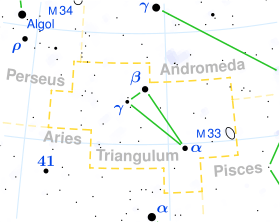Beta Trianguli
Beta Trianguli (Beta Tri, β Trianguli, β Tri) is the Bayer designation for a binary star[11] system in the constellation Triangulum, located about 127 light years from Earth.[1] Although the apparent magnitude is only 3.0,[2] it is the brightest star in the constellation Triangulum.[12]
 | |
| Observation data Epoch J2000.0 Equinox J2000.0 | |
|---|---|
| Constellation | Triangulum |
| Right ascension | 02h 09m 32.62712s[1] |
| Declination | +34° 59′ 14.2694″[1] |
| Apparent magnitude (V) | +3.00[2] |
| Characteristics | |
| Spectral type | A5IV[3] |
| U−B color index | +0.11[2] |
| B−V color index | +0.14[2] |
| Astrometry | |
| Radial velocity (Rv) | +9.9[4] km/s |
| Proper motion (μ) | RA: 149.16[1] mas/yr Dec.: –39.10[1] mas/yr |
| Parallax (π) | 25.71 ± 0.34[1] mas |
| Distance | 127 ± 2 ly (38.9 ± 0.5 pc) |
| Absolute magnitude (MV) | +0.05[5] |
| Orbit[6] | |
| Period (P) | 31.3884 d |
| Eccentricity (e) | 0.53 |
| Periastron epoch (T) | 2432004.255 JD |
| Argument of periastron (ω) (secondary) | 318.4° |
| Semi-amplitude (K1) (primary) | 33.3 km/s |
| Semi-amplitude (K2) (secondary) | 69.2 km/s |
| Details | |
| Mass | 3.5[7] M☉ |
| Luminosity | 74 (combined)[7] L☉ |
| Surface gravity (log g) | 3.70[3] cgs |
| Temperature | 8,186[3] K |
| Rotational velocity (v sin i) | 70[8] km/s |
| Age | 0.73[9] Gyr |
| Other designations | |
| Database references | |
| SIMBAD | data |
This is a double-lined spectroscopic binary star system with an orbital period of 31.39 days and an eccentricity of 0.53.[6] The members are separated by a distance of less than 5 AU.[13] The primary component has a stellar classification of A5IV, indicating that it has evolved away from the main sequence and is now a subgiant star. However, the classification is uncertain and not consistent with the mass derived from the orbit.[7] It is among the least variable of the stars that were observed by the Hipparcos spacecraft, with a magnitude varying by only 0.0005.[14]
Based on observations using the Spitzer Space Telescope, as reported in 2005, this system is emitting an excess of infrared radiation. This emission can be explained by a circumbinary ring of dust. The dust is emitting infrared radiation at a blackbody temperature of 100 K.[13] It is thought to extend from 50 to 400 AU away from the stars.[7]
Naming
- In combination with Alpha Trianguli, these stars were called Al Mīzān, which is Arabic for "The Scale Beam".[12]
- In Chinese, 天大將軍 (Tiān Dà Jiāng Jūn), meaning Heaven's Great General, refers to an asterism consisting of β Trianguli, γ Andromedae, φ Persei, 51 Andromedae, 49 Andromedae, χ Andromedae, υ Andromedae, τ Andromedae, 56 Andromedae, γ Trianguli and δ Trianguli. Consequently, the Chinese name for β Trianguli itself is 天大將軍九 (Tiān Dà Jiāng Jūn jiǔ, English: the Ninth Star of Heaven's Great General.).[15]
References
- van Leeuwen, F. (November 2007). "Validation of the new Hipparcos reduction". Astronomy and Astrophysics. 474 (2): 653–664. arXiv:0708.1752. Bibcode:2007A&A...474..653V. doi:10.1051/0004-6361:20078357.
- Johnson, H. L.; et al. (1966), "UBVRIJKL photometry of the bright stars", Communications of the Lunar and Planetary Laboratory, 4 (99): 99, Bibcode:1966CoLPL...4...99J
- Gray, R. O.; Corbally, C. J.; Garrison, R. F.; McFadden, M. T.; Robinson, P. E. (2003). "Contributions to the Nearby Stars (NStars) Project: Spectroscopy of Stars Earlier than M0 within 40 Parsecs: The Northern Sample. I". The Astronomical Journal. 126 (4): 2048. arXiv:astro-ph/0308182. Bibcode:2003AJ....126.2048G. doi:10.1086/378365.
- Wilson, Ralph Elmer (1953), "General catalogue of stellar radial velocities", Washington, Carnegie Institution of Washington, Bibcode:1953GCRV..C......0W
- Anderson, E.; Francis, Ch. (2012), "XHIP: An extended hipparcos compilation", Astronomy Letters, 38 (5): 331, arXiv:1108.4971, Bibcode:2012AstL...38..331A, doi:10.1134/S1063773712050015.
- Pourbaix, D.; et al. (2004), "SB9: The Ninth Catalogue of Spectroscopic Binary Orbits", Astronomy & Astrophysics, 424: 727–732, arXiv:astro-ph/0406573, Bibcode:2004A&A...424..727P, doi:10.1051/0004-6361:20041213.
- Kennedy, G. M.; Wyatt, M. C.; Sibthorpe, B.; Phillips, N. M.; Matthews, B.; Greaves, J. S. (2012). "Coplanar Circumbinary Debris Disks". Monthly Notices of the Royal Astronomical Society. 426 (3): 2115–28. arXiv:1208.1759. Bibcode:2012MNRAS.426.2115K. doi:10.1111/j.1365-2966.2012.21865.x.
- Royer, F.; et al. (October 2002), "Rotational velocities of A-type stars in the northern hemisphere. II. Measurement of v sin i", Astronomy and Astrophysics, 393 (3): 897–911, arXiv:astro-ph/0205255, Bibcode:2002A&A...393..897R, doi:10.1051/0004-6361:20020943
- Booth, M.; Kennedy, G.; Sibthorpe, B.; Matthews, B. C.; Wyatt, M. C.; Duchene, G.; Kavelaars, J. J.; Rodriguez, D.; Greaves, J. S.; Koning, A.; Vican, L.; Rieke, G. H.; Su, K. Y. L.; Moro-Martin, A.; Kalas, P. (2012). "Resolved debris discs around a stars in the Herschel DEBRIS survey". Monthly Notices of the Royal Astronomical Society. 428 (2): 1263. arXiv:1210.0547. Bibcode:2013MNRAS.428.1263B. doi:10.1093/mnras/sts117.
- "bet Tri -- Spectroscopic binary", SIMBAD, Centre de Données astronomiques de Strasbourg, retrieved 2011-12-12
- Eggleton, P. P.; Tokovinin, A. A. (September 2008), "A catalogue of multiplicity among bright stellar systems", Monthly Notices of the Royal Astronomical Society, 389 (2): 869–879, arXiv:0806.2878, Bibcode:2008MNRAS.389..869E, doi:10.1111/j.1365-2966.2008.13596.x
- Garfinkle, Robert A. (1997), Star-Hopping: Your Visa to Viewing the Universe, Cambridge University Press, p. 238, ISBN 0-521-59889-3
- Stansberry, J. A.; et al. (2005). "A Spitzer Survey for Debris Disks in Binary Star Systems". Protostars and Planets V, Proceedings of the Conference held October 24-28, 2005, in Hilton Waikoloa Village, Hawai'i. Protostars and Planets V. p. 8613. Bibcode:2005prpl.conf.8613S.
- Adelman, S. J. (February 2001), "Research Note Hipparcos photometry: The least variable stars", Astronomy and Astrophysics, 367: 297–298, Bibcode:2001A&A...367..297A, doi:10.1051/0004-6361:20000567
- (in Chinese) AEEA (Activities of Exhibition and Education in Astronomy) 天文教育資訊網 2006 年 7 月 10 日